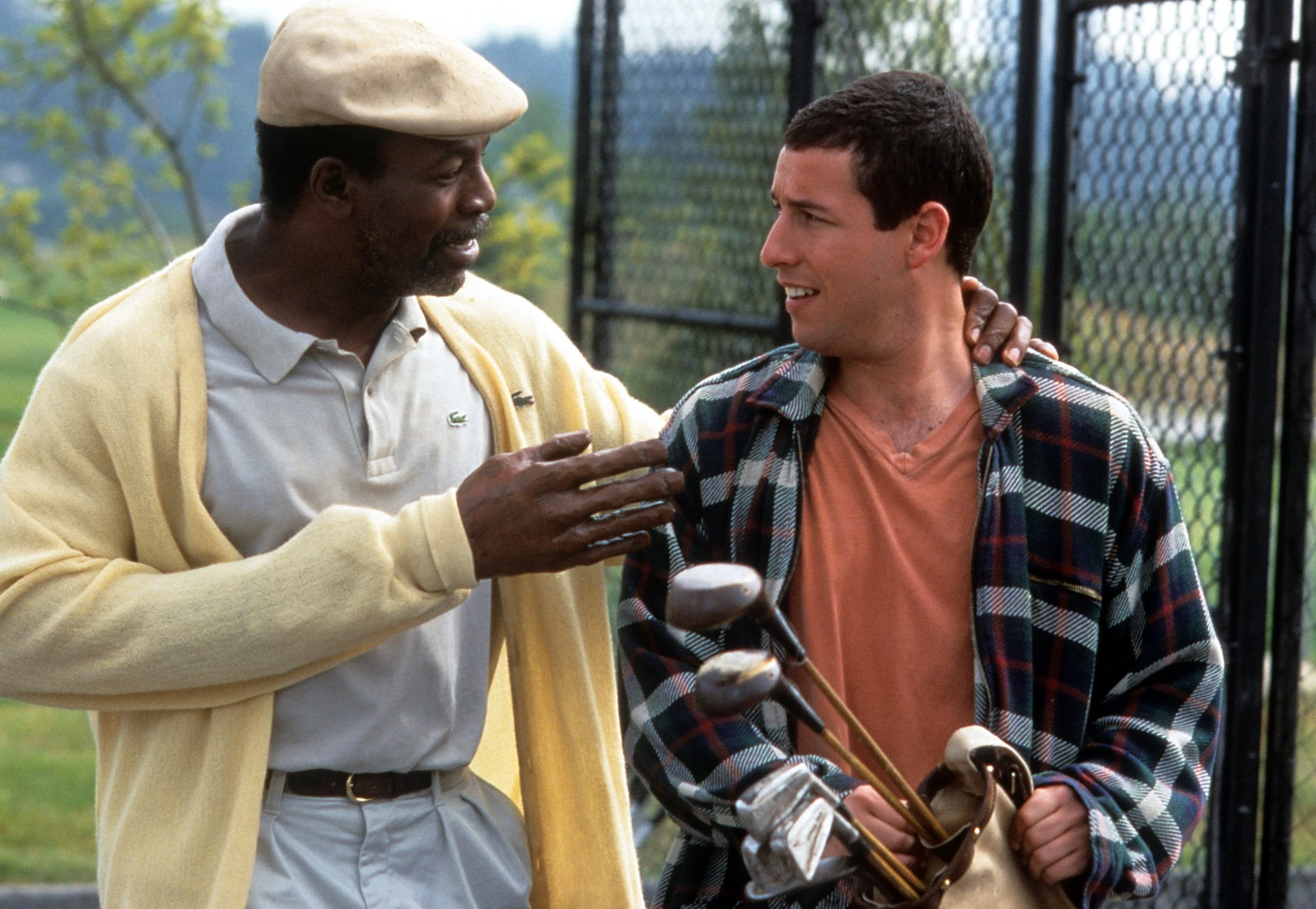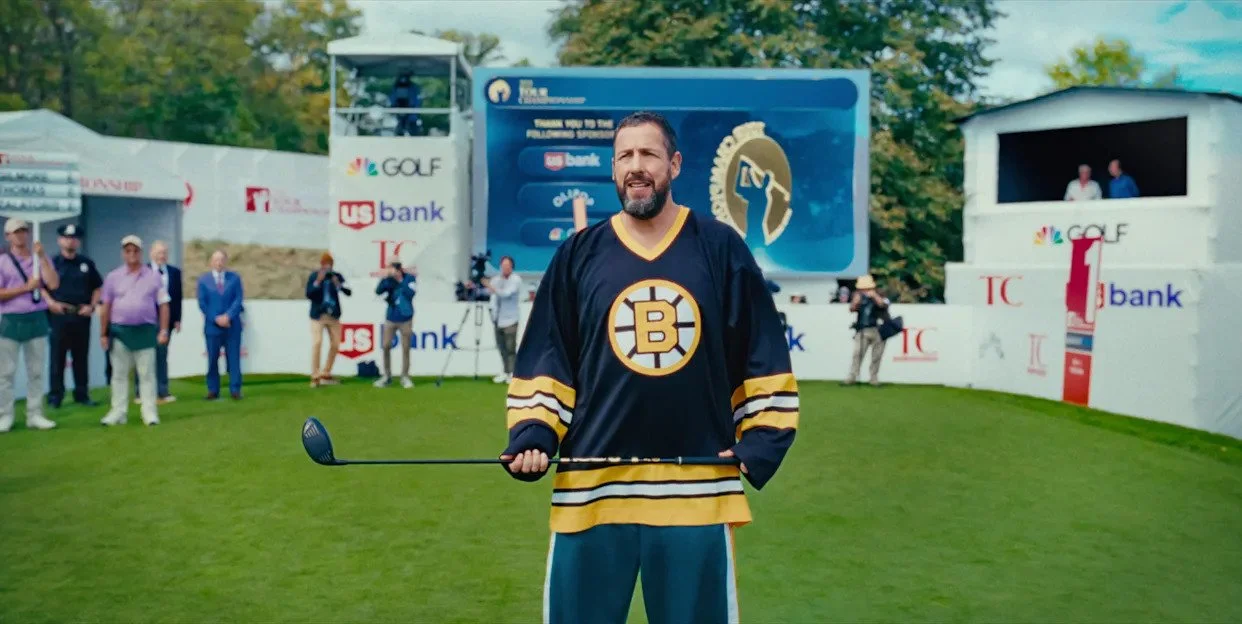Happy Gilmore 2 (2025) Shows Us That Happy Gilmore (1996) Is the Quintessential Adam Sandler Movie
Summer 2025 showed us that Happy Gilmore is the quintessential Adam Sandler movie. On July 25, the legacy sequel, Happy Gilmore 2, premiered on Netflix. As Anders and Aren discussed on the podcast, Happy Gilmore 2 is funny but disposable, more a functional Netflix product and collection of cameos than a coherent, necessary follow-up to the original film. If the purpose of the sequel was to make the streaming charts and renew interest in the Happy Gilmore IP, with parents showing the 90s film to their kids (as I did), then the sequel was a success. Whatever its merits and flaws, Happy Gilmore 2 certainly pushed the original film back into pop culture conversations.
What I also noticed this past summer, though, is that for many people, Happy Gilmore had never faded away. And as a critic, I began to notice the original film’s imprint on almost everything Adam Sandler has made since 1996.
Happy Gilmore is the most perfect example of Adam Sandler’s comedic abilities and appeal, but that doesn’t necessarily make it his best movie. I know some people might point to one of Sandler’s successful romantic comedies, such as The Wedding Singer (1998), as a better movie. Others, especially of the cinephile variety, might point to one of Sandler’s periodic roles in more serious movies, such as Paul Thomas Anderson’s Punch Drunk Love (2002) or the Safdie Brothers’ Uncut Gems (2019), and note that artistic directors have been able to extract the essence of Sandler’s screen characterizations in ways none of his more typical movies do.
While I think there’s some truth to those arguments, I don’t think Sandler has ever topped Happy Gilmore for either the calibre and consistency of the jokes or in terms of cultural impact. If you are a fan of Adam Sandler, this is probably your go-to film of his, and if you are not a fan of Sandler’s shtick, Happy Gilmore is still the film that sums him up the most.
Along with Billy Madison, which came out the year before in 1995, Happy Gilmore and its success made Sandler into a comedy star in the mid-1990s. I remember all the boys parroting Happy’s lines in the schoolyard of my elementary school. Since then, Sandler has put out a string of comedies on almost a yearly basis, and he maintains huge name recognition among audiences. Despite his films usually receiving negative to lukewarm reviews, most of his films have been pretty successful, by which I mean that they are profitable and please their target audiences, even if I avoided most of them and many seem forgettable.
So, my bias is clear. I’ve never been a huge Adam Sandler fan, even if I like some of his movies. But I also believe he has great acting potential that has been successfully mined for artistic purposes in several films, two of which I mentioned above (and I’d throw 2022’s Hustle onto that list as well). But in spite of my preference for certain Sandler performances, Happy Gilmore remains the touchstone for almost everything he has made since.
Sandler’s breed of male character typically involves a combination of naivety, awkwardness, rage, and vulgarity. The stories for his movies typically involve a high concept which is then mined for humour in a series of scenes built around gags and punchlines. The general storyline goes through the usual arcs of underdog triumph or romantic success or personal growth. The romance plots remain adolescent, with touches of sexual interest combined with childish infatuation. Happy Gilmore features all these elements.
In the film, Happy is an eager yet bad hockey player. He has a hell of a shot and is tough and feisty, but he is cut each year when he tries out for the local hockey team because he’s terrible at skating. When a former pro-golfer—Carl Weathers as Derick “Chubbs” Peterson—notices Happy’s grit and is blown away by his ability to drive a golf ball all the way to the green, Happy takes up golf to try earn some money to buy back his grandmother’s house from the IRS. Happy’s unorthodox approach to golf and wild temper gain a fan base—and the eye of one golf tour PR lady, Virginia Venit (Julie Bowen)—as well as enemies in the golf world—particularly the ultra-smarmy top golfer, Shooter McGavin (Christopher McDonald). The rest of the movie is a typical underdog triumph, with all the conventional pitfalls and comebacks. It’s not a bad story, but it is extremely predicatable, and it is used primarily to stitch together funny gags, moments of sentiment, and a few hilarious comedic set pieces, such as Happy’s infamous fight with (the real) Bob Barker.
There is also a lot beyond Sandler’s Happy character that adds to Happy Gilmore and gives it lasting appeal. The humour has noticeable dark streaks, such as an older, richer couple being knocked out at an amazing distance by Happy’s golf swing, or Ben Stiller’s sinister careworker at the old folks’ home. There are also absurd moments, such as Happy’s “Happy Place,” in which he imagines himself drinking beer, accompanied by Virginia in lingerie and a dwarf dancing around. (Happy Gilmore 2 continues these features to shocking and corny levels. In terms of dark humour, I couldn’t believe the sequel would begin with Happy accidentally killing his wife with his powerful golf shot and then becoming an alcoholic. In terms of corniness, his dead wife shows up at several points as a sappy spirit in the clouds comforting him.) Perhaps the funniest dark and silly part of Happy Gilmore is the character of Chubbs. Chubbs had to abandon the pro tour when an alligator bit off his hand; Weathers is game to wear a hilariously long and wooden fake hand throughout the movie, even though it is obviously worn over the actor’s actual hand. The abrupt death of Chubbs, falling out of a window, merits alternately, gasps and chortles, from the audience, as does the vision of Chubbs and the gator in heaven.
Amid the silliness lie a few smarter jokes and critical social observations. Happy Gilmore explores the cultural differences between hockey and golf and between upper and working classes. Happy is viewed by his opponents as an intruder into the golf world, and it has to do just as much with his clothes (baggy track pants and a hockey jersey) as it does with his behaviour (freaking out and attacking people). The inclusion of this kind of humour means that Sandler is also capable of balancing some more sophisticated humour with his broader slapstick and goofiness.
Another reason Happy Gilmore remains funny is that the supporting cast is great. I’ve already mentioned Carl Weathers and Ben Stiller, but Christopher McDonald’s Shooter McGavin is a great smarmy villain (his return adds a lot to the sequel). Julie Bowen, who went on to sitcom fame with Modern Family, has some chances to push back against Happy’s advances and annoyances. And Richard Kiel (who played Jaws in the James Bond movies) has some funny scenes. The original’s handling of select cameos plays to great effect, especially with Bob Barker, whereas the sequel turns into a hangout movie, with everyone just wanting to be in the new Happy Gilmore. The consistent feature seems to be that Sandler has often surrounded himself with other funny people, glad not to keep all the jokes for himself, which is perhaps why seemingly everyone still wants to work with Sandler. This can’t be said about all comedians.
Happy Gilmore also tantalizingly hints at psychological depths that later directors would explore in more serious ways, in films from Punch Drunk Love to Hustle. We see a man-child who is awkward at controlling his emotions, whether in romance or anger, but who also has some sort of innocent charm that allows him to rise about the situation or new setting he has been introduced into. I’m not saying Happy Gilmore is actually deep. I’m saying, rather, that it reveals the strongest features of Sandler’s comedic personality, which other directors seem to have recognized and sought to explore in more serious ways.
While Sandler’s portrayal of masculinity here and elsewhere is worthy of analysis, I don’t want to stretch my case for Happy Gilmore in this essay. The film’s legacy lies not, in the main, with these facets that intrigue me but with the film’s enduring popularity with audiences, such that the filmmakers felt it merited a legacy sequel.
There is no denying that Happy Gilmore has become a touchstone of 90s pop culture and sports culture, finding the sweet spot that connects hockey players with golfers (after all, hockey players stereotypically play golf when they are off in the summer). As I said, all the boys were quoting Happy Gilmore in grade school, and, more recently, all the boys on my son’s hockey team were watching Happy Gilmore and its sequel. In this respect, the film is a sports movie classic, telling a basic underdog plotline in an enjoyable and often hilarious manner. It’s worth revisiting, if you didn’t already do so this past summer.
Happy Gilmore (1996, USA)
Directed by Dennis Dugan; written by Tim Herlihy and Adam Sandler; starring Adam Sandler, Christopher McDonald, Julie Bowen, Carl Weathers, Frances Bay, and Ben Stiller.
Happy Gilmore 2 (2025, USA)
Directed by Kyle Newacheck; written by Tim Herlihy and Adam Sandler; starring Adam Sandler; Julie Bowen, Christopher McDonald, Benny Safdie, Benito Antonio Martínez Ocasio (Bad Bunny), and Ben Stiller.




The Great Escape is a hugely entertaining landmark in the prison camp and action team genres.